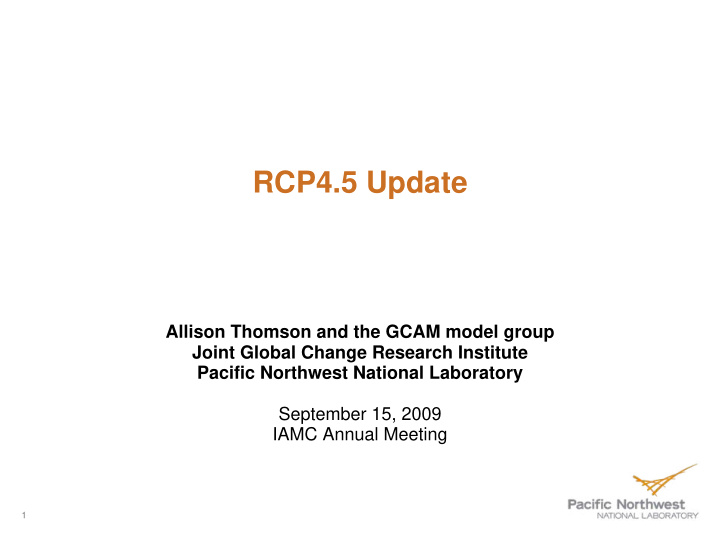



RCP4.5 Update Allison Thomson and the GCAM model group Joint Global Change Research Institute Pacific Northwest National Laboratory September 15, 2009 IAMC Annual Meeting 1
GCAM (formerly MiniCAM) Structure 2
Initial basis for RCP4.5 US Climate Change Science Program scenarios published in 2007. Population peaks at 9 billion in 2065 and declines to 8.7 billion in 2100 Global GDP grows by an order of magnitude by 2100 Energy consumption triples by 2100 Carbon price of $500 per ton C by 2100 Net negative emissions from electric power generation Renewables, nuclear and CCS all deployed Mechanism for valuing terrestrial carbon included Reference: Clarke, L, J Edmonds, H Jacoby, H Pitcher, J Reilly, R Richels. 2007. Scenarios of Greenhouse Gas Emissions and Atmospheric Concentrations. Sub-report 2.1A of Synthesis and Assessment Product 2.1 by the U.S. Climate Change Science Program and the Subcommittee on Global Change Research. Department of Energy, Office of Biological & Environmental Research, Washington, 7 DC., USA, 154 pp. 3
Modifications for the RCP4.5 Scenario drivers and core model assumptions remain the same RCP4.5 was run with an updated version of GCAM: Agriculture, Land Use and NonCO 2 greenhouse gas components updated and fully integrated in O bj ECTS GCAM Updated base year land use and emissions inventories to harmonized RCP data Modified mechanism for valuing terrestrial carbon equally to fossil fuel and industrial carbon Updated version of MAGICC to be consistent with other RCP modeling groups. 4
Results 900 Atmospheric CO 2 Concentration (ppm) 750 CO 2 concentration GCAM RCP 4.5 GCAM RCP reference 600 450 300 1200 geothermal 150 solar 1000 wind 0 hydro 2000 2020 2040 2060 2080 2100 800 nuclear bio w/ccs EJ/yr 600 bio coal w/ccs 400 coal gas w/ccs Primary Energy 200 gas Consumption oil w/ccs oil 0 2005 2020 2035 2050 2065 2080 2095 5
Total Cropland Terrestrial carbon valuation 1600 • Reduce LUC emissions by 1400 Western Europe expansion and preservation of 1200 USA Southeast Asia forests 1000 Middle East millions of ha • Decline in cropland area Latin America 800 Korea Japan 600 India Former Soviet Union Land Use 400 Eastern Europe China Canada 200 Australia_NZ Africa 0 2000 2010 2020 2030 2040 2050 2060 2070 2080 2090 2100 Downscaled for harmonization 6
Beef production Feed for beef shifts into dedicated crops CH4 Emissions from Agriculture 90 180 80 160 70 140 60 beef production 120 50 TgCH4/yr 100 40 80 30 60 20 40 10 20 0 1990 2005 2020 2035 2050 2065 2080 2095 0 2000 2010 2020 2030 2040 2050 2060 2070 2080 2090 2100 Food Crops Fodder Crops Pasture Overall production declines, causing declining emissions 7
Updates since the data release in May Model name – from MiniCAM to GCAM Updates and corrections to emissions BC/OC inventory update and re-release in July Additional correction to shipping grids in September Climate model implementation – land use Initial interpretation of land use by CM groups revealed some larger questions about the harmonization and hand-off steps. Land use downscaling algorithms updated and new products due to be released in a few weeks. Extension to 2300 – remain stabilized at 4.5. 8
Future research directions Continue working with UNH and refining LU downscaling algorithms for GCAM to be consistent with scenario assumptions Implications for harmonization algorithms? Comparison of non-CO 2 GHG emissions across RCP models Development of storylines and communication with users in CM and IAV communities UNH and CM groups meeting this week Continued improvements to the model 9
Recommend
More recommend